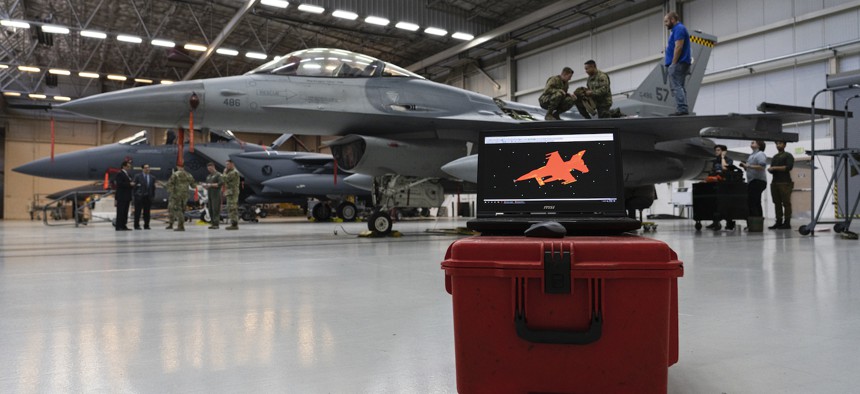
A completed 3-D scan of a F-16C Fighting Falcon is displayed on a screen as technicians maintain at Nellis Air Force Base, Nevada, Feb. 11, 2020. Operators looked to recreate the jet using virtual reality (U.S. Air Force photo by Airman 1st Class Christopher H. Stolze)
Pentagon Wants To Start Testing New 5G Tech Soon
The Defense Department is about to get serious about evaluating next-gen networking gear.
Within the next couple of weeks, the U.S. Defense Department will release a final request for proposals to industry on 5G technology to test at four military bases across the country. That testing, prototyping, and experimentation will include virtual reality tech and sharing portions of the electromagnetic spectrum between DoD and telecommunications companies, according to Defense Department officials.
“DOD is spending hundreds of millions of dollars to set up prototypes at four of our bases around the country where we can invite companies in to test, because we would benefit from 5G,” U.S. Secretary of Defense Mark Esper told the House Armed Services Committee on Wednesday.
Smart warehouse prototypes and testing will take place at Naval Base San Diego in California and Marine Corps Logistics Base Albany, Georgia. Augmented reality and virtual reality tech development and testing will take place at Joint Base Lewis-McChord in Washington. Dynamic spectrum-sharing experiments will take place at Hill Air Force Base in Utah.
Defense spokesperson Lt. Col. Robert Carver said a final request for proposals is due out within the next couple of weeks, following a draft request that went out in December.
Only members of the National Spectrum Consortium may submit proposals.
Among the biggest challenges in creating the communications infrastructure to give both the military and the civilian worlds the connectivity that they will need is spectrum sharing and management. The U.S. military uses a lot of spectrum in what’s called the mid-range, 3,110 to 3,550 MHz, as do the U.S. Departments of Energy, Homeland Security, and Commerce. Next month, the Commerce Department is to report to the FCC on how easy it will be to allow commercial wireless services to share that portion of the spectrum.
“A lot of U.S. companies want to go to the mid... range,” said Esper “It’s where we operate our air defense systems, whether it’s AWACS, whether it's Aegis, or Army and Marine Corps air defense systems. The private sector wants that. We need that. We are willing to share it. We think that’s the way is to share this. The technology is out there, I’m told, to do that. I think that’s the best way to move forward.”




